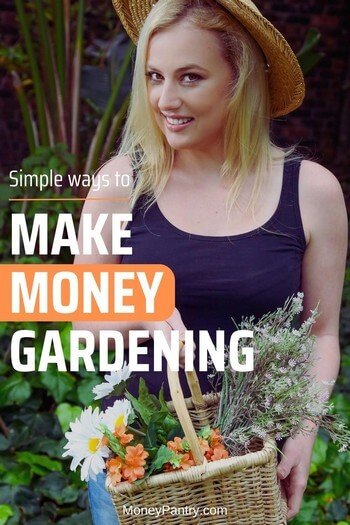
After all, we could all do with more money!
Thankfully, there are plenty of ways to make a profit from your garden.
Table of Contents
How to Make Money Gardening
Let’s get to it.
Here are some of the most profitable ways to make money as a gardener.
1. Sell herbs
Selling herbs is a great way for even the beginner gardener to earn a profit. Herbs are pretty easy to grow and have multiple uses. They can be added to a plethora of dishes and used as a garnish in cocktails too.
FreeCash: Get paid up to $497.82 per offer – test apps, play games, and complete surveys for fast cash! Start earning today!
Earn Haus: Earn up to $25 per survey, plus get paid the same day via PayPal, Venmo, or check! Join Earn Haus now!
InboxDollars: Over $57 million paid to members for watching videos, shopping, and completing surveys. Claim your $5 bonus instantly when you join!
Product Report Card: Get paid to review products from home (payouts from $0.50 to $500)! Join for Free!
KashKick: Earn money watching videos, shopping, surfing the web, and more – PayPal payments are fast! Start earning with KashKick now!
Swagbucks: Watch videos, shop online, take surveys, and more – get $10 instantly when you sign up! Join now and start earning!
2. Sell edible and decorative flowers
Flowers are always popular so sell them to make a profit from your garden. You can sell decorative flowers or edible flowers or both. Just do your research into which flowers are edible and which ones are decorative.
3. Sell seedlings
Seedlings can grow pretty fast and they take up very little space. They also require very little initial investment. So, selling seeds is one of the easiest ways to make money gardening. Many gardeners prefer seedlings instead of planting crops directly from the seed.
You can sell seedlings for things like tomatoes, herbs, peppers, flowers, and whatever else you want.
You can sell them in your own neighborhood or list them on social media and on online marketplaces, like OfferUp, Facebook Marketplace, and Craigslist.
4. Propagate and sell cuttings
Plant propagation is the process of creating new plants. So, you create a brand new plant from one or more parent plants. Basically, it involves taking cuttings from your existing plants, rooting them, usually in water, and then planting them to create a whole new plant.
Selling cuttings enables you to earn a good profit because you don’t have to buy seeds.
5. Make culinary herbal oils and salts
You could make your own herbal oils and salts using herbs from your garden. This is another simple way to make money gardening.
6. Make and sell tea blends
You could make herbal teas using herbs from your garden. Create your own tea blends and sell them for a profit.
7. Be a garden consultant
If you are a skilled gardener, you can make money being a garden consultant. As a garden consultant, you help other gardeners with their gardens. So, you can help them to plan out an ideal layout for a person’s garden or to fix existing problems in someone’s gardener.
This is definitely a good option for experienced gardeners, and you could even set up a website for remote consulting.
Advertisements
8. Start a gardening blog
You could consider starting a gardening blog where you write about various gardening topics. You get to share your knowledge with other gardeners and make money in the process.
There are many ways to monetize a blog, like using affiliate links in your posts and putting Google ads on your site. Check out our post on how to monetize a blog to learn more.
9. Sell produce
People love local produce, which is why selling produce from your garden is such a great money-maker. You could sell produce at your local farmer’s market, set up a roadside stand, or sell to local restaurants, grocery stores, caterers, and event venues.
10. Teach gardening classes
Get paid to share your gardening knowledge and skills by teaching a gardening class. Check with places like local schools, community gardens, garden centers, or even the YMCA to see if they’ll allow you to teach classes at their facility. You could teach classes on everything from garden planning to arranging cut flowers.
11. Write a gardening book
If you enjoy writing in addition to gardening, consider writing a gardening book. You could sell it through Amazon Kindle Direct Publishing (KDP).
12. Make and sell homemade jams and chutneys
You could sell homemade jams and chutneys that you’ve made using home-grown ingredients from your garden. You can even personalize your jams and chutneys with a ribbon and some bespoke handmade packaging.
13. Sell festive gifts and decorations
During the festive season, you could sell homemade gifts and decorations using items from your garden. You could create everything from Christmas bouquets to cards, and lots of other gifts and decorations for the holidays.
14. Sell homemade compost
Compost is important for every garden. You could make money selling homemade compost. A lot of people want homemade compost but don’t have the time or space to make it themselves, so you could sell some homemade compost and make a profit.
15. Set up gardens for other people
Since setting up a garden requires a lot of hard work, many people are looking to outsource it and are willing to pay someone to set up their garden for them.
If you are willing to put in a little effort and manual labor, setting up gardens for other people is a great way to make money gardening.
16. Make & sell candles, soaps, and jewelry
You could use your homegrown flowers and herbs to make candles, soaps, and jewelry. Dried herbs and flowers are great for making handmade crafts that you can sell for a profit.
17. Sell heirloom seeds
Once you harvest your crops, you should be seed saving at least some of your seeds. Not only is this a great way to garden on a budget, but you can also sell these extra seeds. You can make a good amount of cash if you can grow plants that are in demand in your area and sell their seeds.
Just keep in mind that to be successful selling heirloom seeds, you’ll need to sell only high-quality seeds that have a high germination rate. If you can do that though, this is a great way to make money from your garden.
18. Have a you-pick garden
Having a you-pick garden enables you to sell your product at a fair price without having to factor in other costs like transportation and storage that you’d have to consider when selling items from your garden elsewhere.
Good plants for a you-pick garden include things like blueberries, blackberries, raspberries, strawberries, pumpkins, apples, peaches, and pears.
What’s great about a you-pick harden is that you don’t even need to harvest the crops yourself, which saves you a lot of labor.
19. Sell smoothies made with produce from your garden
You could use produce from your garden to make some homemade smoothies. Lots of people enjoy smoothies and you could sell them to make some extra money.
20. Hire out your garden for paint classes and photographers
Artists and photographers want scenes to paint and photograph, which is why you should consider hiring out your garden.
If you have a particularly impressive garden that looks awesome, you could hire it out to painters and photographers. Or, you could paint or photograph your garden and sell your images at craft fairs or as stock photos online.
More Gardening Business Ideas
Need more?
Here are a few more ideas for making money with your garden.
- Sell organic fertilizers or soil amendments
- Grow and sell exotic or rare plants
- Sell handcrafted garden tools or accessories
- Start a garden subscription box service
- Offer plant propagation services
- Sell garden art or sculptures
- Start a plant swap or plant sale event
- Create and sell gardening printable or planners
- Start a gardening podcast or online show
- Offer garden meditation or yoga classes
- Sell edible flowers or microgreens
- Start a community garden and charge membership fees
- Host gardening workshops
- Sell garden crafts
- Create and sell planters or pots
- Sell fresh-cut flowers
- Offer garden design services
- Sell homemade jam or preserves from garden fruits
- Start a seedling nursery
- Offer garden tours or walks
- Grow and sell indoor plants
Obviously, not everyone of these ideas will apply to you, depending one the size and kind of garden you have, as well as the amount of time and work you are willing to pout into it. This is just to get your gardening wheels spinning.
Remember to consider your local market and the demand for these services when deciding which ones to pursue.
Making Money as a Gardener Summary
Now that you’ve learned how to make money gardening, it’s time to put your skills to work and start reaping the rewards.
Whether it’s selling fresh produce, offering gardening services, or creating and selling unique garden crafts, your green thumb can be your ticket to a fruitful and lucrative venture.
Get gardening and watch your profits bloom!




I want to join and make money